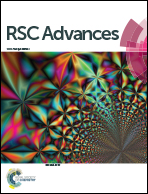Palladium(ii) tetrasulfophthalocyanine covalently immobilized on keratin protein grafted graphene oxide nanosheets as a new high-performance catalyst for C–C coupling reactions
Abstract
Wool keratin protein, as an amphiphilic biomaterial, was extracted from natural wool and used to modify the surface of graphene oxide nanosheets. An aqua soluble palladium(II) complex with a phthalocyanine ligand possessing the ability to covalently bind on keratin-protein-grafted graphene oxide nanosheets was used to chemically attach palladium(II) complex to modified graphene oxide. The covalently supported palladium(II) tetrasulfophthalocyanine complex revealed efficient catalytic reactivity by controlled temporary release of active species for Heck and Sonogashira coupling reactions in aqueous solution. Heck coupling of styrene and Sonogashira coupling of phenylacetylene with different aryl halides were successfully catalyzed by the synthesized palladium(II) tetrasulfophthalocyanine covalently supported on keratin-protein-grafted graphene oxide nanosheets as a novel catalyst precursor. The controlled release of palladium active species prevents the formation of inactive palladium agglomerates under harsh conditions and consequently this controlled release leads to high catalytic performances.


 Please wait while we load your content...
Please wait while we load your content...